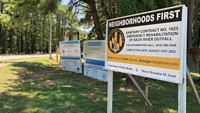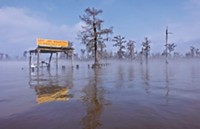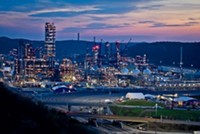Advertisement
Grab your lab coat. Let's get started
Welcome!
Welcome!
Create an account below to get 6 C&EN articles per month, receive newsletters and more - all free.
It seems this is your first time logging in online. Please enter the following information to continue.
As an ACS member you automatically get access to this site. All we need is few more details to create your reading experience.
Not you? Sign in with a different account.
Not you? Sign in with a different account.
ERROR 1
ERROR 1
ERROR 2
ERROR 2
ERROR 2
ERROR 2
ERROR 2
Password and Confirm password must match.
If you have an ACS member number, please enter it here so we can link this account to your membership. (optional)
ERROR 2
ACS values your privacy. By submitting your information, you are gaining access to C&EN and subscribing to our weekly newsletter. We use the information you provide to make your reading experience better, and we will never sell your data to third party members.
Greenhouse Gases
Podcast: Lake Maurepas is a battleground for climate change mitigation
Reporter Rick Mullin details a community’s struggle against companies forging forward in their use of carbon capture and sequestration on C&EN Uncovered
by Craig Bettenhausen , Mark Feuer DiTusa
May 16, 2023

Carbon capture and sequestration is the trapping of carbon dioxide emitted by industrial processes and depositing it beneath the Earth’s surface. Spurred on by tax credits offered by recent federal legislation, companies are racing to implement the technology in geologically-suitable locations such as in Louisiana. However, the community around Lake Maurepas, Louisiana, has resisted efforts by Air Products to green-light such a project under the lake. In this episode, C&EN reporters Rick Mullin and Craig Bettenhausen discuss the fears of the community around the implementation of carbon capture and sequestration around Lake Maurepas and the response from Air Products.
C&EN Uncovered, a new project from C&EN’s podcast, Stereo Chemistry, offers another look at subjects from recent cover stories. Read Mullin’s April 2, 2023, cover story about carbon capture and sequestration around Lake Maurepas at bit.ly/3W4lbCE.
Subscribe to Stereo Chemistry now on Apple Podcasts, Spotify, or wherever you listen to podcasts.
The following is a transcript of the episode. Interviews have been edited for length and clarity.
Craig Bettenhausen: Welcome to C&EN Uncovered. I’m Craig Bettenhausen. C&EN Uncovered is a podcast project from Stereo Chemistry. In each episode, we’ll take another look at a recent cover story in Chemical and Engineering News and hear from C&EN reporters about striking moments from their reporting, their biggest takeaways, and what got left on the cutting-room floor.
In this episode, we’re looking at a story by Rick Mullin about Lake Maurepas, which is a lake in Louisiana. This story came out in the April 3 print edition of C&EN. And I’m here with Rick. Hi, Rick.
Rick Mullin: Hi.
Craig: So maybe you can start off for the people that haven’t had a chance to read this article, just give a brief summary of what happens in the story.
Rick: Well, the story involves a technique called carbon capture and sequestration, which involves capturing CO2, usually from an industrial source, and storing it or depositing it more than a mile beneath the surface. The story covers community resistance to this being done under a lake, Lake Maurepas, which is a rather large lake just to the northwest of the better-known Lake Pontchartrain, not far from New Orleans.
There were three companies, projects that I’m writing about, Occidental Petroleum’s unit, OxyChem, and CF Industries in a partnership with Exxon and Air Products.
Craig: So, you went down there toward the end of your reporting process and spent a couple days down there. But in particular, you attended one specific community meeting that was organized more by the community than by the company, right?
Rick: Yes, this meeting was organized by the Lake Maurepas Preservation Society, which is a group formed by community members. Prominent among them is my source from the group in the story, Caleb Atwell, and the feeling was that many in the community had attended meetings in which Air Products explained the project and answered questions. They were largely dissatisfied with what they heard from Air Products. And it was thought that they would put on a presentation with sources familiar with carbon capture and sequestration and familiar with the project.
Craig: One of the concerns that residents raised in your story was about the idea of a leak or a rupture where the CO2 doesn’t stay underground. And there have been some prominent CO2 leak incidents in the past. I wonder if you could tell me a little bit about how the severity and the frequency of CO2 accidents compares with some of the other kinds of spills that even in the same community, like petroleum and chemical spills, have been in the past?
Rick: Well, there were two incidents that came up in the story—things that actually happened that people are afraid could happen if projects go forward. One is a rupture of the CO2 pipeline in Satartia, Mississippi, which is the western part of the state not very far from Lake Maurepas, more or less the same geological situation. That sent a lot of people to the hospital and was a CO2 pipeline not unlike the CO2 pipelines that would be involved in transporting carbon dioxide some 40 miles, say, from the proposed Air Products plant to the lake.
The other thing that people bring up is Bayou Corne, where a salt-dome well collapsed and created a sinkhole that destroyed a community; people lost their homes. People point to these incidents as areas of concern. And the response from industry on the Bayou Corne situation is that the wells, or that well was not comparable to the types of wells that are used in carbon capture and sequestration, which are more than a mile underground. The pipeline leak Satartia, what can you say? A pipeline leak is a pipeline leak, and it’s a reasonable concern for anybody that’s going to have a CO2 pipeline, you know, go through their neighborhood or by their kids’ school.
Craig: How dangerous is this relative to some other kinds of spills? Because we just had another chemical spill in Ohio that you also wrote about, and how do these kinds of incidents compare and their severity to the community?
Rick: It’s not the sort of disaster that you see in East Palestine or you know, something like that. It’s hard to say, you know, there are chemical spills that are much more dangerous than a CO2 pipeline breaking, but, again, tell that to the people who went to the hospital. You know, it’s hard to compare them.
Craig: So you’ve covered fence-line communities, which is… communities that are nearby to chemical facilities and are the most directly impacted by their environmental impact before, but CO2 sequestration is kind of a new area. How did this happen to catch your attention?
Rick: It was the Deep South Center for Environmental Justice’s executive director, Beverly Wright, who alerted me to concerns about carbon capture and sequestration in Louisiana, on behalf of the people who live closest to the source of the CO2 or the CO2 that might be generated in new plants. What I found was that the stronger community pushback was from the area that the CO2 would be transported to via pipeline and deposited. And that is the community, the communities, around Lake Maurepas, which consists of four or five Louisiana parishes. So that’s what got me started on it.
Craig: And so you actually went down to visit these communities, like, in person.
Rick: It’s impossible really to write these stories well without meeting people and having the chance to, you know, to have these serendipitous encounters with sources you would never have found, you know, sitting in your office on the phone. And it’s very hard really to write about it unless you’re there and get just a feel for how people are feeling what, you know, what the impact of the project would be and what the communities are like that you’re writing about.
For example, Caleb Atwell recommended that I stop in at Middendorf’s restaurant in Manchac, which has this tremendous fried catfish on the menu. And coming from New Jersey, I had to get me some fried catfish. I met, you know, I met a waitress there, and we got to talking about you know, what I was doing there eating catfish. And I told her I was writing the story. And she said, “Oh, you’re talking about the folks that want to put the carbon dioxide or something under the lake.” I said, “Yeah.” She goes, “Well, there they are!” I looked out the window and there was a barge, which I hadn’t noticed that had pulled up and was working on, I believe they were working on seismic testing; they were probably drilling. And, you know, the folks that were working on it had come into the restaurant and told her about it. And that’s how she knew about it. That was sort of an interesting encounter.
Another person that I met at the meeting—I actually just randomly sat down next to her—was one of the best interviews. She is a retired postal worker. She has a commercial fishing license, and she said that, you know, life on the lake has already been affected. The fishing is not is no good; you can’t fish in the water is murky and muddy. And I think it’s because of the seismic testing. She has a private well near the lake. She has a camp near the lake, which is sort of a you know, it’s a house on the lake. And what she said was, look, my children work in this industry. We support the industry; the industry creates jobs. But you know, Exxon is doing their deposit on their property on the Gulf of Mexico. We think that maybe Air Products could do the same thing.
Craig: So your article goes into some of the geology and the already-built industry that kind of supports this as a project. But I wonder if you could say a little bit more about the political scene in Louisiana that’s also kind of lubricating projects like this.
Rick: That’s a big question. Louisiana has a reputation for saying yes to industry. It is central to the economy. But you know, it’s really what you see on the surface to a certain extent, that there is a lot of industry there. You know, the river from New Orleans to Baton Rouge is, as most people know, is popularly referred to as—or often referred to as—Cancer Alley, because of the impact of industrial pollution on those communities. And there are several instances of communities organizing in opposition to industry. One of the most prominent ones recently is Rise St. James, which has been opposing Formosa’s plan to build a large plastics plant. This story is almost sort of a curveball in all of this, because we’re talking about a project that’s being presented as sort of a green industrial project by industry. So it’s a little more complicated than a petrochemical company saying, we’re going to build a plastics plant and the community saying, we oppose this. One of the main points that so many people made is that we don’t understand this yet. And that’s something that the industry sources who would speak with me said as well: that we’re facing a situation where people are unfamiliar with a technology that is proven being implemented in an area that’s very familiar with wells, pipelines, and industry. This combination of wells, pipelines, and industry that come together for carbon capture and sequestration raises a lot of questions in the minds of the people that will be closest to the operation.
Craig: So the story came out on April 3, but even in that short time between then and now there’s been some action.
Rick: Yeah, the state legislative session began in April. And just last week, about 50 people from across the south of the state went to Baton Rouge for what was called Lobby Day. And a lot of what went on was centered on carbon capture and sequestration. There’s currently eight bills related to—I’m going to call it CCS—that are right now in the House Committee on Natural Resources in the state. One of the representatives who I met briefly, Bill Wheat, has a bill that would put forward a moratorium on drilling activity.
Among other bills is one that would require that the deposit sites be moved to industrial areas on the Gulf Coast. And not in a place like Lake Maurepas. It has to be said that Lake Maurepas does not have a lot of industry in its vicinity. Right now there are 50 some small wells most, if not all, inactive. Lake Pontchartrain and Lake Maurepas really sort of stand out in the region for not as not being heavily developed by industry.
Craig: I know that there’s a number of projects in other parts of the state. Are these bills being written specific to this parish? Are they going to affect Louisiana Green Fuels and other projects in other parts of the state?
Advertisement
Rick: The bills are not concentrating specifically on, say, the Air Products project or the CF Industries project. They are looking at carbon capture and sequestration. And they’re, you know, there is prominent support, just even last week, from folks that see the technology as proven, as something that will generate jobs, and, of course, as a means of getting to net zero. You know, one of the things that’s accelerating activity is the Biden administration’s Inflation Reduction Act, which has significantly increased the tax benefit for capturing and depositing CO2 as part of the broader net-zero-by-2050 goal.
Craig: Great, well, thank you for coming in and telling us all about this story today. Once again, this was in the April 3 issue of Chemical & Engineering News, or you can also find it online, you can search for Rick Mullin. My name is Craig Bettenhausen; you can find me on social media as @CraigOfWaffles. We put a link in the show notes along with the episode credits. We’d love to know what you think of C&EN Uncovered. You can share your feedback with us by emailing cenfeedback@acs.org. This has been C&EN Uncovered, a series from C&EN’s Stereo Chemistry. Stereo Chemistry is the official podcast of Chemical and Engineering News. C&EN is an independent news outlet published by the American Chemical Society. Thanks for listening.
CORRECTION:
This article was updated on May 16, 2023, to correct the name of the lake in the headline. An editing error rendered the name as Lake Maurepaus instead of Lake Maurepas.





Join the conversation
Contact the reporter
Submit a Letter to the Editor for publication
Engage with us on Twitter